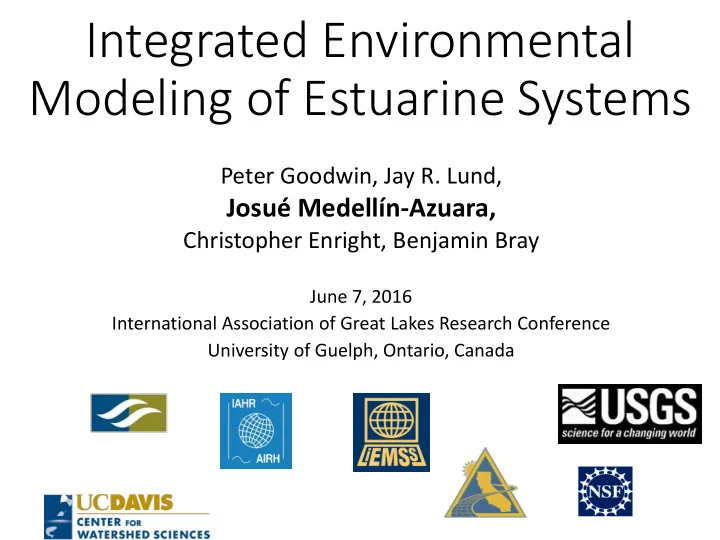

Integrated Environmental Modeling of Estuarine Systems Peter Goodwin, Jay R. Lund, Josué Medellín-Azuara, Christopher Enright, Benjamin Bray June 7, 2016 International Association of Great Lakes Research Conference University of Guelph, Ontario, Canada
Authors Team • Robert Argent , Bureau of Metereology Melbourne, AU • Jiro Ariyama , California Delta Stewardship Council • John F. Bratton , Limnotech • Alvar Escriva-Bou , Public Policy Institute of California • Joseph Lee , Hong Kong University of Science and Tech. • Steve Lindley , US Geological Survey • Michael McWilliams , Delta Modeling Associates & AnchorQEA • Nigel Quinn , Reclamation, L. Berkeley National Laboratory • Stuart Siegel , Siegel Environmental • John Wolfe , Limnotech • Integrated Environmental Management of Estuarine Systems Symposium Participants http://integratedmodeling.ucdavis.edu
Estuarine Systems • About 22% of the cities in the world are located in estuaries • Provide ecosystem services and resources to support human needs and economic development in regions • Subject to stress from many sources including • Changes in streamflows • Waste and nutrient management http://marlimillerphoto.com/estuaries.html • Loss of habitat • Fisheries • Invasive species
Estuary ry Systems are In Inherently Complex • Physical Processes • Multiple objectives • Stakeholders • Upstream water users Complexityexplorer.org • Water diverters • Dischargers • Interests • Analysis is hard Bratton, DePinto, Wolfe (2015)
Models are useful, yet often create interdisciplinary lines • Models • Improve understanding individual processes • Organize information and discussions • In complex systems like estuaries • Disciplinary lines • Reinforces fragmentation of science, management and policy discussions • An interdisciplinary approach is needed, no single discipline is sufficient Lesswrong.com
Symposium on Integrated Environmental Modeling of Estuarine Systems • Funded by NSF, the California Delta Stewardship Council and UC Davis Center for Watershed Science • May 21-23,2015 at UC Davis • About 160 attendees • Government agencies, academia, consulting firms, NGOs • http://Integratedmodeling.ucdavis.edu
Symposium on Integrated Environmental Modeling of Estuarine Systems: Guid iding Pri rinciples 1. Credibility, legitimacy and relevance 2. Models are never completed, just enhanced, evolved or abandoned 3. Implicit analysis of uncertainty and sensitivity 4. No generic model will address system complexity for every location 5. Common protocols should be encouraged
Integrative Approach Elements • Data infrastructure • Data driven models and data mining • Open source • Visualization and virtualization • Facilitate communication Lach (2016) • Inform decision makers • Assist communication of issues • Community modeling
Some Institutional and Technical Approaches can Help • Institutional • Venue for Agencies, consulting firms, academia, stakeholders • Institutional support, funding • Transparency and access to data and information • Moving from authority and competition to collaboration • Development of interdisciplinary scientific understanding • Modular modeling • Component based • Open source • Data infrastructure • Visualization and virtualization Peckham et al. (2013)
Water Resources in California Hanak et al. (2011) Managing California’s Water 10
Problems of California’s Sacramento -San Joaquin Delta • Physical instability • Land subsidence • Sea level rise • Floods • Earthquakes • Ecosystem instability • Habitat alteration • Invasive species • Economic instability • High costs to repair islands • Worsening water quality for agric. & urban users 11
Cali lifornia faces the hig igh-stakes task of f improving the Delta’s ecosystem health • Multiple stressors are harming native species • Scientific uncertainty, costs of mitigation fuel “combat science” • Fragmented institutions impede effective management • No time to waste for Most Californians use Delta resources environment, economy and share responsibility for its ecosystem woes 12
A Delta Modeling Collaboratory • Physical location • Minimum staff • Venue for collaborative work • Model repository • Conceptual model development • Forum for problem solving: • algorithms, • data infrastructure, • web service interface
A Business Case Attribute Current Practice Proposed Approach Financial costs and Project specific Economies of scale for financing general capability and staff for specific project, Fragmentation and Costs of fragmented Reduce fragmentation inefficiency modeling high Maintaining capabilities Costly for entities to Lower costs distributed maintain across entities Timeframe of information Drawn out, discussion on Common models details, small group Integrated understanding Discipline specialization Multidisciplinary Prioritizing model and Difficult to achieve Coordination committee data Access to modeling Institutional barriers Broad access, available expertise resources, rapid to teploy Building and retaining Limited career paths, Opens career pat, long term talent misalignments, mentoring collaboration to build expertise supports agency program
Collaboratory ry Addit itional Features • Establish and manage in partnership UC, USGS, CWEMF, Delta Science, NGOs and private • Problem based, convene modelers • Physical location with meeting space and virtual network • Minimum staffing • Capacity and contracting ability to Description 1st Year 2st Year 3rd Year 4th Year 5th year and later receive funding 1 2 3 4 5 6 7 8 9 10 11 12 Development specific proposal for Delta Modeling Center Funding Aquirement • Training for managers, legislative Formation of a Model Coordinating Committee/Board of Directors Development of a common modeling plan staffers, modeling experts Collaborative modeling of Delta management in drought Data sharing and its platform development Development of web interface, animations, • Business model developed and descriptions Establishment of the Delta Modeling Center Improvement in fish/ecosytem modeling Improvement in operations and water curtailments modeling • Support conceptual models and Improvement in economics modeling Continuous model update and integration Development of cooperation mechanism facilitation of regular updates Actions with focus time Consistent Effort Timeline
Concluding Remarks • Estuaries are complex systems • Models help improve quantitative understanding • Fragmentation occurs and creates inefficiencies • Successful schemes involve integration, cross- discipline, openness, data infrastructure • No perfect data, no perfect models, learn from mistakes, hard to change the paradigm • A Collaboratory can help advance research for managing estuarine systems
Thank You jmedellin@ucdavis.edu jm jmedell llin@ucdavis.e .edu
Recommend
More recommend